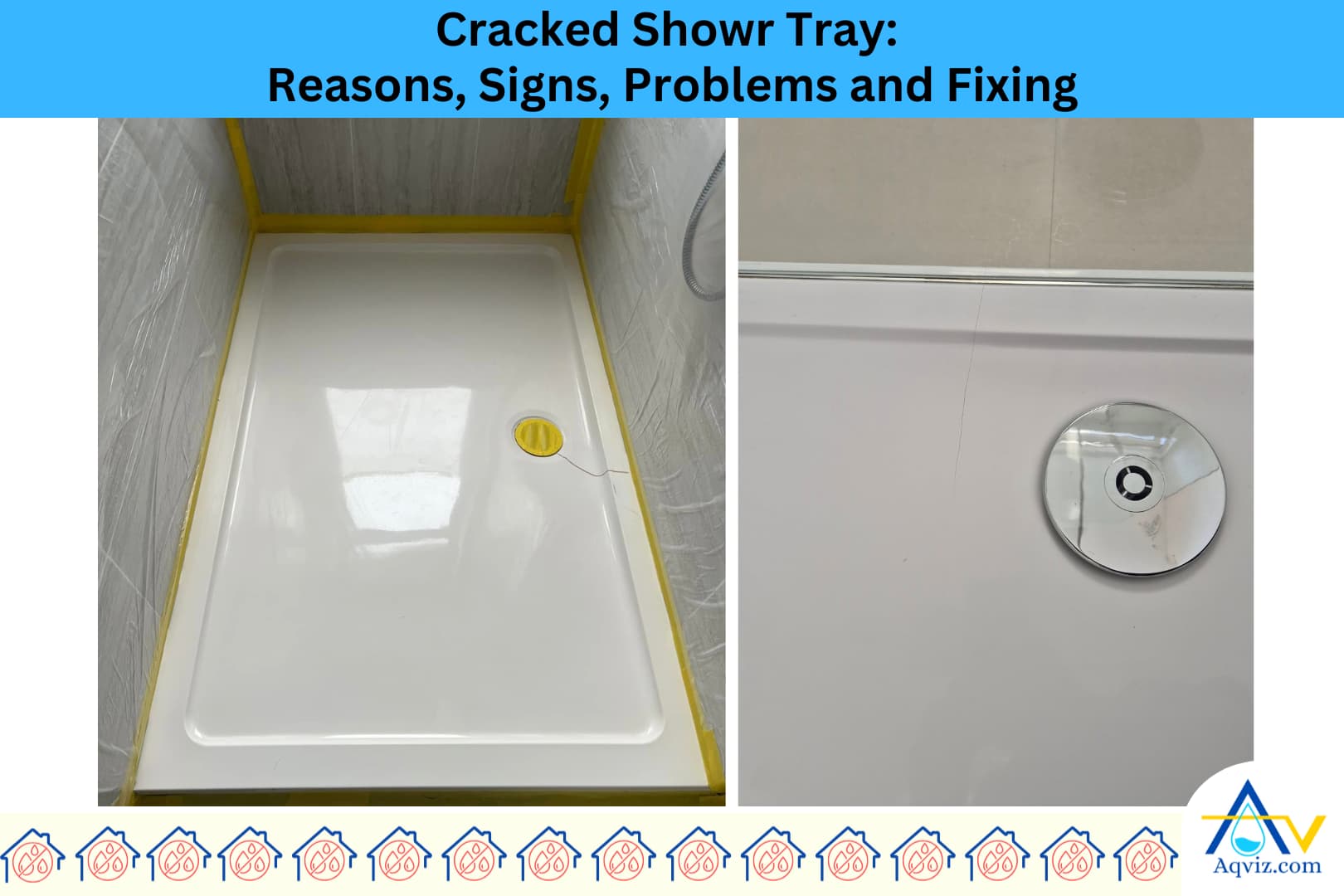Cracked Shower Tray: Reasons, Problems and Fixing

A cracked shower tray is visible with fractures or splits in the surface of a shower base. Shower tray cracks are developed due to inadequate support underneath, poor installation, impact from heavy objects, thermal stress, and material fatigue over time.
These cracks tend to leak water beneath the floor, and this leads to serious water damage, including mold growth, floor damage, slip hazards, tray instability, and decreased property value over time.
To prevent these problems, Aqviz experts highly recommend you repair the shower base properly using a shower tray repair kit. You can use any shower tray repair kit related to your shower base material. And also, you must waterproof the bathroom even if you use a shower tray. It helps to protect the structure from accidental shower base leakages.
Do you have a bathroom water problem or damage? Let’s connect with Aqivz. We will support you to fix it asap.

What is a Cracked Shower Tray?
A cracked shower tray is visible with fractures or splits in the surface of a shower base. Shower base cracks develop due to inadequate support underneath, poor installation, impact from heavy objects, thermal stress, and material fatigue over time. A cracked shower tray causes continuous water seepage into screed layers, plywood subfloors, and behind wall tiles. It leads to various water damages such as ceiling stains, mold and mildew growth, material deterioration, and wood rotting in the structure.
To prevent these serious damages, Aqviz experts recommend replacing or repairing cracks using two-part epoxy filler or fiberglass repair kits. And also, we highly recommend that you should install a waterproofing membrane or reinforce joints with butyl tape on backer board on the bathroom floor to prevent leakage from a cracked shower tray.
Read More About: Bathroom Waterproofing: Everything You Should Know
What are the Reasons for Cracks on the Shower Tray?
There are 5 reasons for cracks on the shower tray, including inadequate support underneath, poor installation, impact from heavy objects, thermal stress, and material fatigue over time.
- Inadequate support underneath : Shower trays crack if there’s not enough support underneath. When we step on the tray, it flexes under our body weight, and that movement puts stress on weak spots. Over time, this leads to surface cracks.
- Poor installation : If the tray isn’t leveled or secured properly, it shifts every time we use it. This repeated movement builds up tension around the corners, drain area, or edges. That stress weakens the material, causing cracks to form within just a few months after installation.
- Impact from heavy objects : Dropping shower hardware, tools, or large bottles onto the tray surface can cause immediate chips or stress cracks in older or thinner resin and ceramic-coated trays.
- Thermal stress : Rapid temperature changes from alternating hot and cold water cause expansion and contraction in the tray material.
- Material fatigue over time : Continuous exposure to moisture, weight, cleaning agents, and daily use degrades the surface coating of low-grade shower trays.
What are the Problems of Using a Cracked Shower Tray?
There are 6 problems of using a cracked shower tray, such as water leakage, mold growth, floor damage, slip hazards, tray instability, and decreased property value. Continued use of a damaged tray negatively affects bathroom safety, hygiene, and structure.
- Water leakage into subfloor : A cracked shower tray allows water to escape through the fracture into the tile bedding, screed, or wooden subfloor. This constant seepage leads to moisture buildup and weakens the floor structure.
- Mold and mildew development : Water trapped beneath a cracked tray creates a damp environment under the surface. This promotes hidden mold growth that affects air quality and increases maintenance costs.
- Damage to surrounding flooring : Leaks from a cracked tray spread to nearby floor tiles, grout, and baseboards. This moisture loosens tile bonds and stains surrounding materials, lowering the durability of the entire bathroom floor.
- Slip and fall hazard : A cracked surface can have uneven or raised edges or may become slippery due to constant water pooling. This increases the risk of slip-related injuries during shower use.
- Tray movement and instability : A cracked tray often loses its structural rigidity, causing flexing or creaking during use. This instability leads to further cracking and undermines the shower’s safe operation.
- Reduced property value : A visibly cracked shower tray signals poor maintenance and potential water damage. This negatively impacts buyer confidence and reduces the resale value of the home.
How to Repair a Cracked Shower Tray?
To repair a cracked shower tray, you should follow the 6-step guide below. At Aqviz, we use this method when restoring acrylic, fiberglass, or resin trays to stop leaks and restore structural stability.
- Clean and dry the tray surface : First things first, you should clean the cracked area using soap, warm water, and a plastic scrub brush to remove grime, soap scum, and oils. After rinsing, you should dry the surface thoroughly with a clean microfiber cloth and let it air dry for 30 minutes.
- Sand the cracked area: Then, using medium-grit sandpaper (120-180 grit), you should sand around the crack to roughen the surface. This step helps the repair materials adhere better and removes any gloss finish from the tray’s surface.
- Widen and inspect the crack: Then, you should gently open the crack using a utility knife or rotary tool to create a V-groove. This allows the filler to bond deeper into the crack. And also, you should inspect to ensure the crack hasn’t spread into the substructure if it has, full replacement may be needed.
- Apply a fiberglass or epoxy repair kit: For acrylic or fiberglass trays, you can mix a two-part epoxy resin or use a fiberglass repair kit. Using a plastic applicator, as well as you can fill the crack with the mixture and press fiberglass mesh over it (if included in the kit). You should smooth it out and let it cure as per the manufacturer’s instructions.
- Sand and finish the surface: After curing, you can sand the area with fine-grit sandpaper (220-400 grit) to blend the repair with the surrounding surface. Then you can wipe it clean using isopropyl alcohol and prepare it for finishing.
- Apply waterproof sealant or topcoat: Finally, you should apply a waterproof gelcoat or tray refinishing spray over the repaired area to match the original color and add a protective seal. This step prevents moisture penetration and restores the tray’s appearance.
Aqviz Experts have investigated all of the bathroom water damages and listed out the 8 most common water damage in the bathroom and prepared a complete guide for each water problem with including reasons, signs, problems, and how to fix it properly as an expert. So we highly recommend you to refer to all of these 8 bathroom problems.
- Bathroom Sink Drain Leak
- Bathroom Faucet Leak
- Hot Water Leak
- Toilet Leak
- Bathroom Sink P Trap Leak
- Bathtub Overflow
- Bathroom Broken Tiles
- Bathroom Mold
Should you Shower With a Cracked Shower Tray?
No, you should avoid showering with a cracked shower tray continuously. Because water can leak from the cracks and damage to floor by increasing dampness and humidity. This caused serious water damage to the structure, including mold and mildew growth, wood rotting, swelling, ceiling stains, musty odor, and more.
Is it Safe to Use a Cracked Shower Tray?
No, it’s not safe to use a cracked shower tray. From our experience at Aqviz, cracked trays become slippery, unstable, and may develop sharp edges that cause injuries. As well as water leaking through the crack can also increase the serious water damage to the structure.
